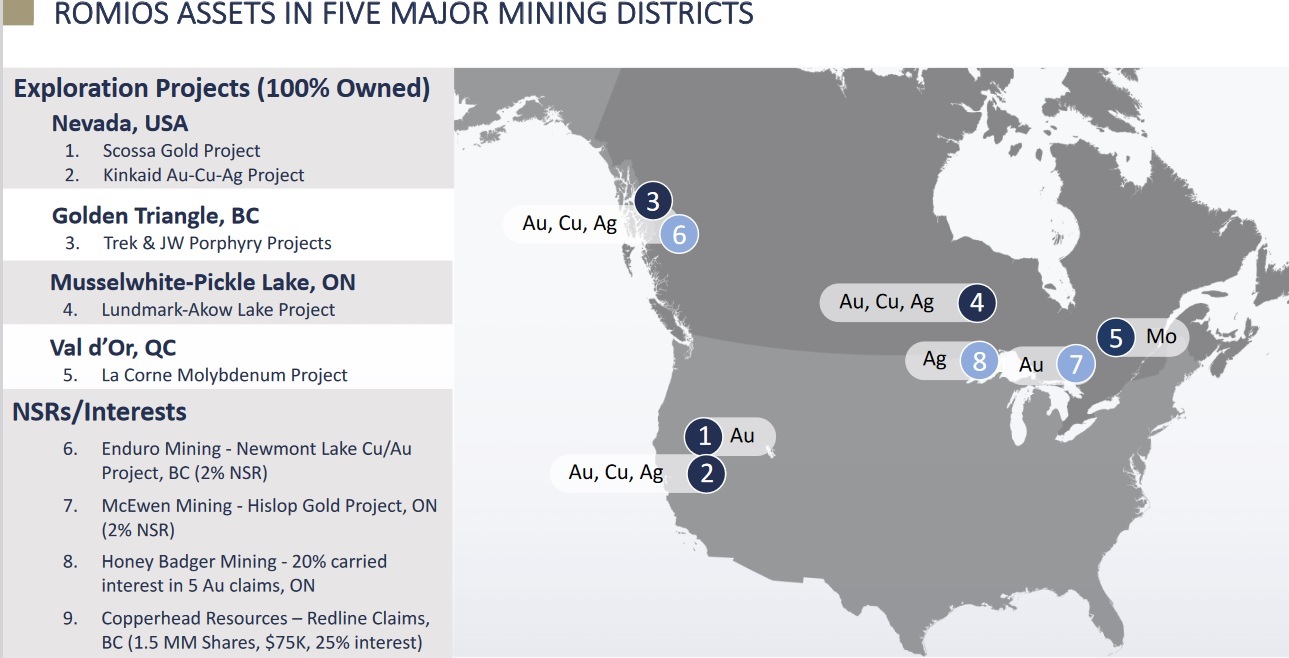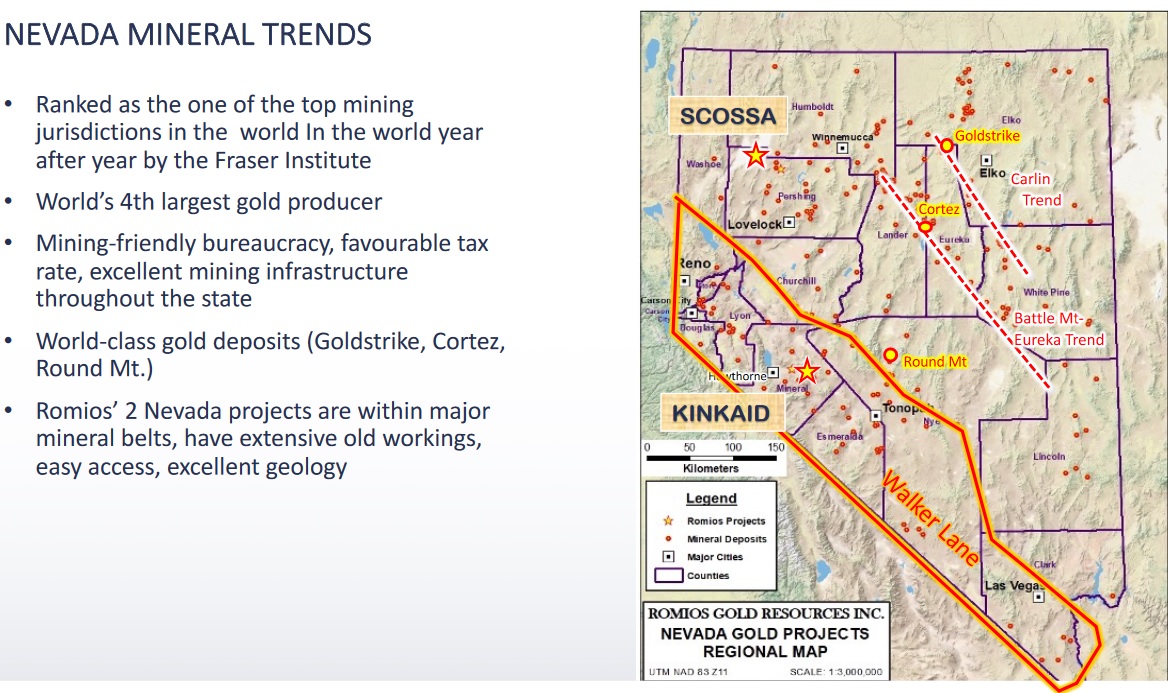Romios Gold continues to get gold, copper & silver showings at their two Nevada Projects, but can they hit the jackpot?
Romios Gold Resources Inc.‘s (TSXV: RG | OTCQB: RMIOF) (“Romios”) focus is on gold, copper and silver exploration in North America. Romios has a 100% interest in five properties in northwestern Ontario, Canada but their recent focus has been on their assets in Nevada, USA.
Therefore today’s article will give an update on Romios’ two projects in Nevada, the Kinkaid Gold-Copper-Silver Project and the Scossa Gold Project.
A summary of Romios’ assets spread across North America focusing on gold, copper and silver

The Kinkaid Gold-Copper-Silver Project (Nevada, USA) (100% owned)
The Kinkaid Project has dozens of old mine workings and prospect pits from the 1930s and ‘40s and includes the historic Montreal Gold-Silver mine.
Various prospecting over recent years has found a number of positive results including:
- In 2021, a small-scale historic mining operation on the southern claims assayed 212 g/t silver (6.8 oz/t Ag), 2.3% copper and 1 g/t gold.
- Chip and grab samples from two old trenches returned assays of 13.5 g/t gold and 4.34% copper from one trench and 5.8 to 36.3 g/t gold and 1.55% to 4.8% copper from another.
- Mineralized veins adjacent to garnet skarn workings (“P.M. Prospect”) on the northern claims also returned excellent results including 1,725 g/t silver (55 oz/t Ag), 6.9% zinc, 0.4% copper, plus lead, antimony, arsenic, and mercury.
- In May 2022, high-grade assays were reported from the southern claims of up to 17.9 g/t gold and 6.59% copper.
- 2023 exploration discovered three copper-bearing samples from the Dry Gulch #2 skarn in the NE corner of the Kinkaid claims assayed 1.1%, 7.2% and 16.55% copper across different intervals 20-40 cm wide.
- 2023 exploration from dumps at a previously unmapped old adit and shaft on a swarm of quartz-sulphide veins in the central Kinkaid claims returned gold assays of 2.4, 5.5 and 32.0 g/t gold and copper assays of 1.27% copper to 3.22% copper.
Romios stated in May 2023: “(Romios) commenced a program of detailed geological mapping and sampling across the Kinkaid property with emphasis on the numerous mineralized showings. Diamond drilling of several showings is anticipated in 2023.”
Romios stated in July 2023 that they intend to “further refine the geological model of the Kinkaid mineralization” and “at this point, various geophysical, geochemical and geological options are under consideration for detecting and outlining any possible porphyry/plutonic systems beneath the veins and skarn occurrences on the Kinkaid claims. Work at Kinkaid is expected to resume in September, 2023.”
The Scossa Gold Project (Nevada, USA) (100% owned)
The Scossa Gold Project covers a former high-grade gold mine that was in production from 1930-1941 and where historic drill programs intersected ‘bonanza’ (super high) grades over multiple meters.
What’s interesting is that past mining only reached as deep as 400 feet (~122 meters). Romios state that “large sections of multiple veins have not been drilled, and there are some newfound areas of potential vein development”.
Romios conducted drilling programs in 2002, 2003 and 2006, intersecting bonanza grade gold mineralization in several shallow holes including 3.35 m @ 180.2 g/t gold. There was also one rock chip sample assaying 25 g/t gold. Romios model shows a high potential target area down plunge of the past mining that has not been drilled and now becomes a high priority target of the next drill campaign.
One new area of potential vein development was found from an assay of 10.2 g/t Au which was returned from a sample of a >1 m wide quartz vein exposed 340 meters south along strike of the main veins at the historic Scossa Gold Mine site.
In a July 31, 2023 market update Romios stated:
“Several days were spent prospecting and mapping areas north and south along strike of the >700 m long epithermal vein system that produced high-grade gold ore averaging more than 1 ounce/ton (31.1 g/t) gold during mining operations in the 1930s……The 340-meter gap between the known veins and this new discovery is now considered highly prospective for extensions of the Scossa gold vein system and will be explored in the coming months through a combination of detailed geological mapping, soil sampling and hand-trenching where appropriate.“
Romios’ 2 Nevada projects (Kinkaid & Scossa) are within major mineral belts in Nevada, the world’s 4th largest gold producing region

Source: Company presentation
Closing remarks
Romios has recently completed fieldwork programs on the Kinkaid and Scossa Projects in Nevada. Both have returned encouraging results from new areas that have expanded the potential extent of both mineralized systems. Findings so far have included some good gold, copper, and silver grades. The next challenge is to discover larger mineralized zones that can be drilled and potentially produce some long drill lengths leading to a potential resource.
Meanwhile, Romios also has their numerous other projects, notably in Canada (details in an InvestorNews video here).
Romios Gold Resources trades on a market cap of only C$7 million, meaning any significant discovery can have a huge impact on the stock. One to follow in 2023.
